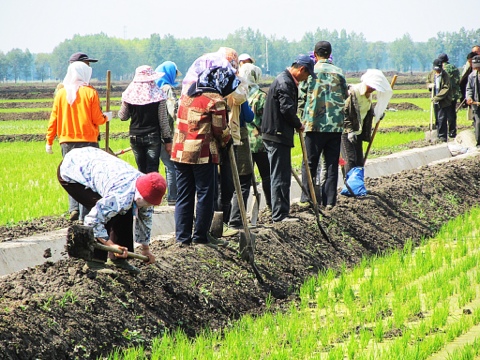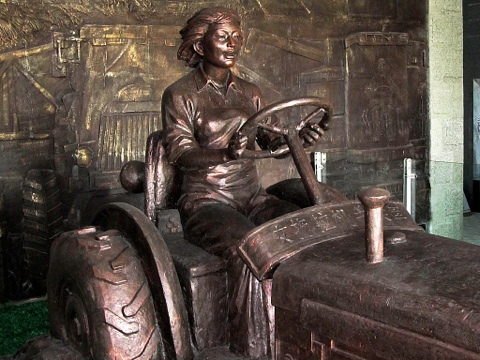HONGXINGLONG, China — When she was a very young woman Liang Jun was one of the tens of thousands of durable adults dispatched by China’s new Communist Central Government in the early 1950s with orders to break open the prairie of this cold and formidable northeast province. Until agronomists and engineers from the Soviet Union offered their assistance, and their steel-tracked grey tractors, the work of cutting open land that was bound together by the uncut roots of centuries of tall prairie grasses was done by hand, one chop and heave at a time.
Workers lived in crude grass and sod and wooden huts. Winter temperatures can plunge here to 35 degrees below Fahrenheit. Summers are hot. Women worked alongside men, their hands protected by thick cotton gloves. They wrapped white scarves around their hair and faces, the long tails streaming in the wind.
Liang Jun is in her 80s now and lives in Harbin, a provincial capital city of 10.6 million people 700 kilometers west of this modern prairie city of 40,000. She doesn’t grant interviews, farm officials told me. Her place in Chinese history, though, needs no further explanation from a western writer. She is the first woman to drive a tractor in Chinese agriculture, the first female credited with participating in the mechanization campaign that turned this province into the largest grain producer in a nation that harvests more grain than any other country on Earth, including the United States.
For a time Jun’s image graced the 1 RMB notes that today are worth a little more than 16 cents. A more permanent honor, a bronze statue of Jun driving a 1950s Soviet-era tractor, is at the center of a handsome ultramodern glass and aluminum museum that honors the machines and productive prairie agriculture the Chinese developed here and on 113 other state-owned farms in Heilongjiang Province.
More than a year ago, as a researcher and writer at Circle of Blue, I reported on the urgent water shortage developing in the Yellow River Basin, which lies west of Heilongjiang. The provinces of the Yellow River Basin produce 20 percent of the country’s grain and 70 percent of its coal, China’s number one source of energy.
Both sectors are the region’s largest water users. Both also are at significant risk of collapse because climate change is steadily reducing levels of rain and snowfall and draining freshwater reserves. By 2020, without significant water conservation initiatives, and as China’s demand for energy and food increases, we concluded there would be a damaging gap in the basin’s available fresh water supply amounting to 20 billion cubic meters. In other words, farmers and energy producers will be 20 billion cubic meters short of the water they need to operate.
We presented this finding to scientists and engineers at the Ministry of Water Resources in Beijing in April 2011. When I asked what they were doing in response, they told us about developing policies to significantly modernize and expand irrigation networks and water conserving technologies and practices in Heilongjiang (pronounced hail-long-jong) and three other northeastern provinces — Liaoning, Jilin, and eastern Inner Mongolia. I replied that we’d be back.
Here we are, accompanied by Wu Jing Yang, our accomplished and indefatigable researcher and translator. It’s our fourth day in northeast China, a region visited by few foreigners and even fewer Americans. The complete findings will be available online later this summer.
I learned that this region, a land now of rice paddies full of growing green shoots and enormous fields of just plowed and planted corn and soybeans, is in the third great chapter of its farm development. Over the next five years, the Central government will spend almost 8 billion RMB ($1.3 billion) in Heilongjang to build new concrete canals, end the leaks in old ones, buy drip irrigation equipment, install state-of-the-art low-flow sprinklers, and take other measures to bring water to plant roots while also not testing the boundaries of the province’s water supply, which is generally plentiful but can also be unstable.
The goal is to increase yields at least 20 percent over the next half-decade, a goal that has domestic food security significance here, and global market importance in the United States, where farmers are enjoying the highest commodity prices of their lives.
It’s interesting stuff. A lot of what the Chinese government wants to do with water conservation and new irrigation practices on small farms has been developed and proven out on some of the world’s biggest farms, including the 264,000-acre YouYi Farm here, the largest in China. Yields on the mechanized and irrigated farm, about the size of a small American county, are equal to and often exceed the top American farms. More than 80 percent of its 1-million-ton harvest of rice and corn, and 150,000-ton sugar beet crop, is exported to other provinces, said the farm executives I met.
The YouYI Farm is owned and managed by the Central government in a state farm system unique to this province, and now the world with the collapse of the Soviet Union and its state farms. More than 120,000 people work on the YouYi farm and its related production and processing enterprises that form, quite literally, a world of their own. The 3,300 acres of sugar beets raised in immense irrigated fields are processed in the town’s sugar mill. Same for rice and corn. Layers upon layers of farm managers provide employment for top technical graduates, some of them the grandsons and granddaughters of the first generation farmers that include Liang Jun.
The schools, hospital, equipment repair shops, housing, community center, hotels, and other public institutions are managed by the regional farm oversight office here, housed in a grand granite and glass building. The city of wide concrete boulevards, bright street lights, magnificent parks, brand new high rises and shopping centers rises unexpectedly after a trip through dusty villages over cracked and crowded roads, past fields of new rice and corn where weeding is still done by hand.
In one way or another everybody connected to the YouYi Farm is descended from Liang Jun.
— Keith Schneider




